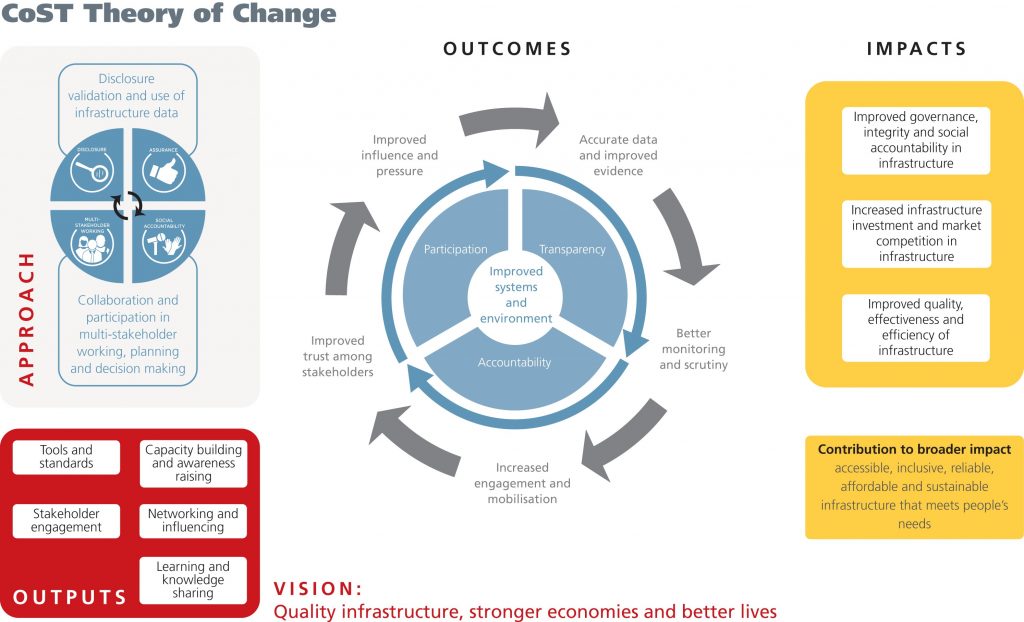Joanne Coysh, CoST Strategic Adviser outlines the participatory process she facilitated to develop our new, robust Theory of Change.

A year ago this week, we initiated a participatory review engaging staff, members and other stakeholders to better understand how CoST contributes to the vision of ‘quality infrastructure, stronger economies, better lives’, exploring the different pathways of this contribution which could be mapped in a Theory of Change (ToC).
With many perspectives and ideas on how change happens, gathering, unpacking and reaching agreement on the core factors takes time but is a key investment. This participatory process has promoted broad reflection and learning across CoST about how CoST member programmes are achieving impact, adapted or improved, where necessary.
Why a Theory of Change?
Our new Theory of Change is an adaptive framework, which essentially serves three important purposes.
- It is a conceptual framework – explaining the different components of CoST programme activities and defining outcomes and impacts.
- It is a monitoring and learning tool – mapping out a series of connected short- and medium-term outcomes and assumptions that can be measured against relevant indicators.
- Importantly it demonstrates an adaptive approach to programming – where the mapped ideas are applied, tested and refined according to what is happening in practice and what can be learnt from the evidence emerging from member country contexts.
Critical in the process to crafting the ToC was to identify the many assumptions we make about how our particular actions led to particular outcomes, which then need to be tested in practice.
How do we think change happens through CoST?
The CoST vision is founded on the belief that quality infrastructure is essential to well-functioning economies, improving business access to markets and enabling quality services such as schools, hospitals, water facilities and energy to be delivered to citizens. And in its delivery, the positive economic, environmental, social and development impact is maximised to meet people’s needs.

Transparency, participation and accountability are key to our vision. These principles contribute to improved systems of governance and social accountability based on rigorous processes and the inclusion of different stakeholders and the integrity of working models. As CoST evidence shows, heightened disclosure, validation and use of infrastructure data, together with inclusive planning and decision-making can contribute to outcomes that improve these principles.
Over recent years evidence shows how our impact has covered three key areas: improved governance and social accountability; increased infrastructure investment and market competition; and better quality, effective and efficient infrastructure. However, there is still much to learn about the pathways of change and the relationship between the activities, approach, outcomes and impacts. Our reflections revealed that in the past we may have relied too heavily on the thinking that evidence generated by a CoST member programme would trigger a government response, and instead our conversations highlighted that a diverse range of factors come into play and need to be considered. For example, how informal dialogue with a CoST multi-stakeholder group or external pressure from the media, private sector or civil society can lead to increased transparency and accountability in infrastructure data and decision making.
We have become more conscious about how pathways to change are not linear. Instead, CoST is part of a broader process of complex and systemic change involving many actors. It is important that we remain aware of the various social, economic and political factors that can influence our impact and how member programmes can adapt to these.
What has changed?
Our new ToC shows how our thinking has advanced around the interconnected and complex nature of how change happens. As a process, it draws out the assumptions upon which we plan and design programmes. By placing transparency, participation and accountability at the core, we can focus on the various ways these can be achieved and the pathways to impact.
Our previous ToC was more linear and highlighted the need for governments to adopt CoST. In the new version, while government adoption and their responses are important, we recognise that this is one amongst many factors that will then influence how change takes place and that the government is one of many stakeholders who can influence change.
What next? Applying the Theory of Change to member programmes
As a monitoring, evaluation and learning tool, the CoST ToC requires a shift in focus to projected outcomes and impacts, helping us to ask more critical questions about our approach and to better understand the enabling factors that contribute to the outcomes and impact.
Importantly, the ToC provides immense value for our members to monitor how change is happening in practice and whether it has come about as planned. As the CoST model is adapted by members to ensure programmes suit the diverse political, economic and social contexts in which they operate, members can now use the ToC framework to understand how their flexible model is working, assessing their respective pathways to achieving outcomes and impacts to do so. We will be encouraging our members to use the ToC to consistently improve their approach and ensure they are responsive to unexpected events and the uncertain contexts in which we live.
Importantly the process we have taken over the past year has allowed us to appreciate how learning and knowledge sharing are an integral aspect of our work. It has shaped how we will monitor, evaluate and learn, and it has helped us to develop robust indicators to assess how programmes create change. Only through this on-going learning process involving different stakeholders will we really understand how change happens and the ways that CoST can best contribute to ‘quality infrastructure, stronger economies, better lives.’
